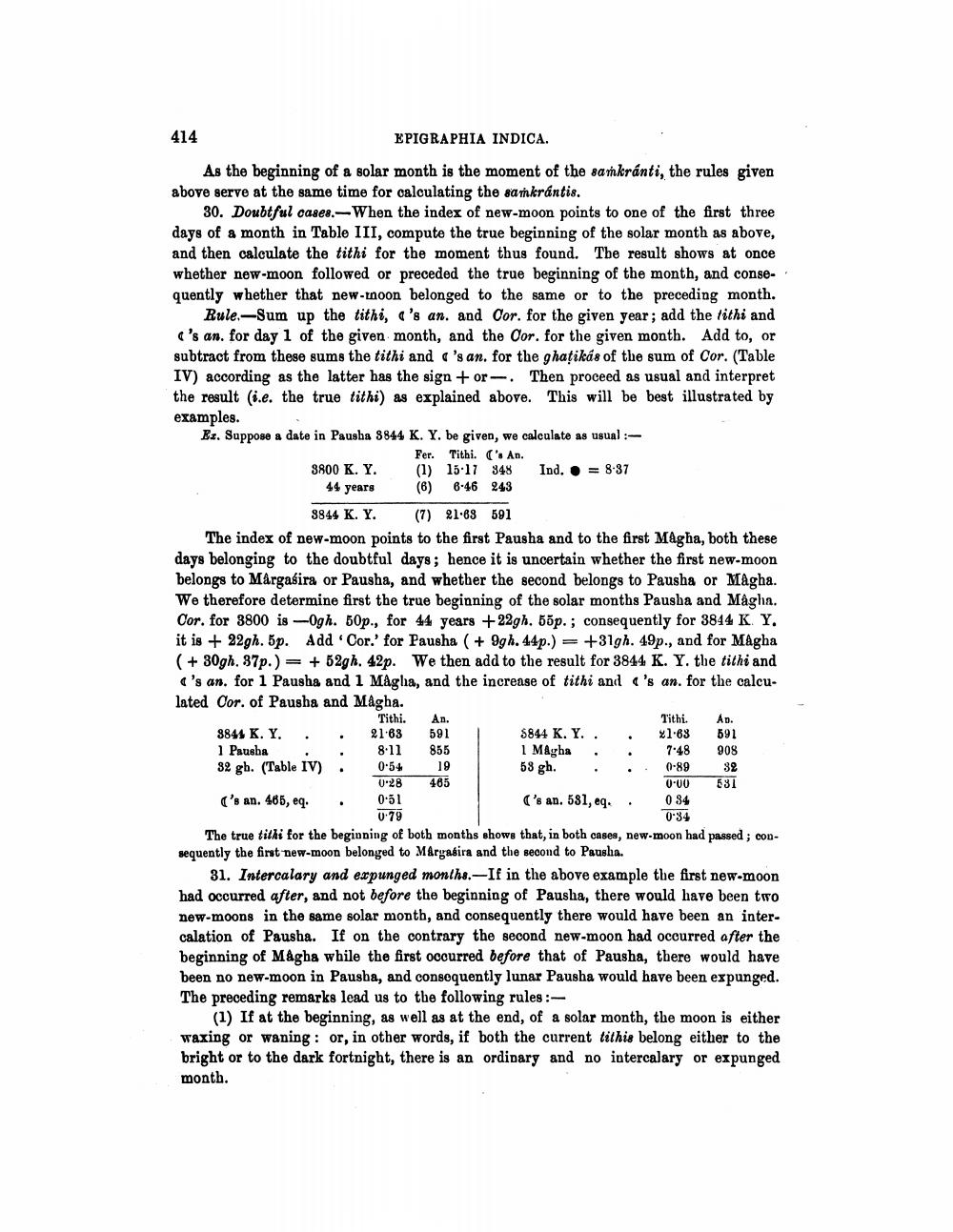________________
414
EPIGRAPHIA INDICA.
As the beginning of a solar month is the moment of the sankranti, the rules given above serve at the same time for calculating the sankrantis.
30. Doubtful cases. When the index of new-moon points to one of the first three days of a month in Table III, compute the true beginning of the solar month as above, and then calculate the tithi for the moment thus found. The result shows at once whether new-moon followed or preceded the true beginning of the month, and consequently whether that new-noon belonged to the same or to the preceding month.
Rule.-Sum up the tithi, ('s an. and Cor. for the given year; add the tithi and I's an. for day 1 of the given month, and the Cor. for the given month. Add to, or subtract from these sums the tithi and 's an. for the ghatikás of the sum of Cor. (Table IV) according as the latter has the sign + or --. Then proceed as usual and interpret the result (i.e. the true tithi) as explained above. This will be best illustrated by examples. Ex. Suppose a date in Pausha 3844 K. Y. be given, we calculate as usual :
Fer. Tithi. ('. An. 3800 K. Y. (1) 15:17 348 Ind.. = 8-37
44 years (6) 6-46 243
3844 K. Y. (7) 21.63 591 The index of new-moon points to the first Pausha and to the first Magha, both these days belonging to the doubtful days; hence it is uncertain whether the first new-moon belongs to Margasira or Pausha, and whether the second belongs to Pausha or Magha. We therefore determine first the true beginning of the solar months Pausba and Magha. Cor. for 3800 is --Ogh. 50p., for 44 years +22gh. 5öp.; consequently for 3844 K Y. it is + 22gh. 5p. Add Cor.' for Pausha ( + 9gh. 44p.) = +31gh. 49p., and for Magha (+ 30gh. 87p.) = + 52gh. 42p. We then add to the result for 3844 K. Y. the tithi and C's an. for 1 Pausha and 1 Mágha, and the increase of tithi and 's an. for the calcu. lated Cor. of Pausha and Magha. Tithi. An.
Tithi. Ap. 8844 K. Y. . . 21.63 591
$844 K. Y. . .
591 1 Pausha
8:11 855
1 M&gha . . 748 908 32 gb. (Table IV) 0:54 19
58 gh. . .. 0-89 32 465
0:00
581 ('s an. 465, eq. 0.51
('s an. 581, eq.. 034 0.79
0:34 The true titki for the beginning of both months shows that, in both cases, new-moon had passed; consequently the first new-moon belonged to Margasira and the second to Pausha.
31. Intercalary and expunged months.- If in the above example the first new-moon had occurred after, and not before the beginning of Pausha, there would have been two new-moons in the same solar month, and consequently there would have been an intercalation of Pausha. If on the contrary the second new-moon had occurred after the beginning of Magha while the first occurred before that of Pausha, there would have been no new-moon in Pausba, and consequently lunar Pausha would have been expunged. The preceding remarks lead us to the following rules :
(1) If at the beginning, as well as at the end, of a solar month, the moon is either waxing or waning : or, in other words, if both the current tithis belong either to the bright or to the dark fortnight, there is an ordinary and no intercalary or expunged month.
0-28




